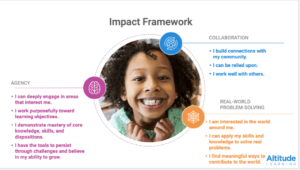Supporting Statewide Change Through Virtual Course Access Models

CARES Act funding encourages states to develop or expand statewide virtual learning and course access programs, opening up options for students to access high-quality learning experiences never offered in physical buildings. This priority enables states to expand access to all students, while ensuring learners and parents have a say in what the offerings might be.
This opportunity comes at a time when the limitations of virtual learning are clearer than ever. Through this priority, states have the chance to apply lessons learned from the past six months to take a leap forward in the quality and reach of virtual programming.
A leapfrog moment
Most statewide virtual learning systems were developed in a way that transferred the current learning paradigm online through traditional courses and grading models. This approach may work well for some learners, but it fails to leverage the potential of technology to recenter our education system around the learner and create a system that works for all children.
Towards a learner-centered future
States wishing to pursue this strategy should think about how opening this portal can catalyze positive change across the entire system. There are always bright spots in our schools. This has been no different during the pandemic. But the decentralized nature of the system, coupled with the practical constraints like schedules, buildings, and transportation make scaling these success stories exceedingly difficult. Statewide virtual programming has the potential to avoid both of these barriers to scale and impact, serving as the catalyst for the shift to a new, learner-centered model for learning and school.
Meeting the needs of every family
To achieve this potential, states should embrace the opportunity to develop a more direct relationship with students and families through this virtual infrastructure. Combining effective user research and engagement with the data and analytics potential of the technology, there is an opportunity not only to understand unmet learning demands, but to actually shift the relationship from a transactional back and forth, to a productive partnership in support of the learning needs and goals of each child.
Know the risks
While the potential upside is compelling, there is also significant risk. One of the most significant, we believe, is underestimating or underinvesting in the human dimension of this virtual system. Another is over anchoring on traditional features such as courses, units, and outcomes, in a way that misses some of the biggest opportunities.
Don’t forget the educator
The most powerful virtual learning programming amplifies, not replaces, the best that educators bring. Engage educators early and often, and consider ways to expand access to extraordinary teaching. Seek ways to bring new educators into the system through flexible, technology-enable logistics. Creating an educator-centered experience is a necessary aspect of creating a learner-centered one.
Think in recipes, not ingredients
Too many school experiences already end up a hodgepodge of ingredients that we hope adds up to a decent recipe in the end. Just adding more course offerings to the mix is only so helpful. Think in meaningful sequences. Combine skill-building through adaptive learning technologies with authentic learning that requires deep thinking. Create pathways that enable students to move at flexible paces based on mastery, and enable students to engage deeply in areas of interest becoming experts and learning how to learn.
Make your recipe knowing who will eat it
Most learners are motivated by relationships. Virtual learning opens up new opportunities for relationship building in ways that were sometimes pursued but extremely difficult to scale in traditional physical environments. Instead of building in advisory and peer relationships as an afterthought, incorporate them into the design from the beginning. Similarly, learners are motivated by authentic work and audiences. New models can combine asynchronous knowledge acquisition strategies with real-world learning and public products in a way that is almost impossible in an analog system – but only if these ingredients are included in the recipe.
Getting started
States wishing to pursue this priority should plan a nuanced approach to stakeholder engagement, define high-quality virtual learning, and take steps early on to ensure system interoperability while taking advantage of the opportunity to think PK-16.
Understand the options
There are important design differences in online options, with different benefits. Taking some time upfront to understand them is a smart way to get started. For example, in a teacher- delivered online class, the teacher delivers content, facilitates discussion, assigns tasks, provides feedback, and modulates pacing. A cohort of students enrolls over a semester or school year. In an asynchronous course there are rolling or frequent enrollment dates, and the learner progresses through assignments at their own pace with some teacher support and monitoring. Advising, support, and tutoring may be unified or disassembled.
Define what success looks like
This priority asks states to decide on their approach to developing their portfolio of virtual learning options. States need to analyze and determine their expectations for quality upfront and be prepared to stop any offerings that fail to meet this standard. States should lean heavily on their instructional leaders and master educators to define the vision while aligning with national efforts underway to expand how we think about student success. States should be transparent about how they will decide what options make it out of the gate.
Think PK-16
States are uniquely positioned to create connections between higher ed and high school, an opportunity enhanced by virtual learning opportunities at both levels. States should consider this feature from the beginning, and take steps to increase alignment. At the same time, there is a need to improve virtual offerings in younger grades since previous efforts have been heavily high-school focused. Much has been learned about effective virtual learning at lower grades, and again, there is the opportunity to create a system that is more coherent, not less.
Build the conditions for partnership
Rethinking K-12 systems involves bringing in voices and opinions of those often uninvited and establishing multi-directional communication. By involving parents and parent organizations at the front end, states will gain a fresh perspective. Parent liaisons can support and organize these conversations. States need to show that this co-construction approach benefits all parties while substantively responding to the community’s ideas. This will require understanding how to connect with rural communities and those who do not normally feel welcome or included.
Ensure system interoperability
Whatever approach you take, you need to make sure this new system is able to talk with both district and state data systems. Course coding, matching student identification information, and tracking attendance, should all be part of early conversations to make sure your tech teams and systems can move forward with this priority. Along the way, you are sure to find areas to update. A future-ready student information system has options for competency-based grading, communicating with students, and viewing progress in relation to your definition of success.
Operationalizing this strategy
The above points seek to clarify the vision for what a successful virtual course access program might look like, how to avoid getting it wrong, and what needs to be included in order to get it right. But how should SEAs approach implementation? How should they be thinking about the process of delivering this kind of system on an extremely rapid timeline?
About the Moving Forward Together coalition
The Moving Forward Together coalition coalesced around the opportunity to build an agile coalition to support SEAs in responding to the current crisis in a way that helps SEAs create a better, more learner-centered system. Anchoring this coalition are:
- Altitude Learning provides learner-centered technology solutions to support competency-based, personalized and authentic learning both through LEAs and direct to families through Altitude Learning @Home. Leaders in learner-centered technology and practice, Altitude’s staff literally wrote the books on Learner Centered Leadership and Learner Centered Innovation.
- Getting Smart is a prolific thought leadership in learning innovation uniquely situated to help LEAs establish your approach to innovating for your state’s context. Getting Smart provides a variety of key implementation supports from program design to communications.
The coalition is led by Devin Vodicka, Chief Impact Officer at Altitude and former CA Superintendent of the Year, and Tom Vander Ark, CEO at Getting Smart, former Superintendent in WA State, and the first Executive Director of Education for the Bill & Melinda Gates Foundation.
Other “Moving Forward Together” partners will be pulled in as needed to bring their unique expertise to bear supporting SEA plans. They include: Digital Promise, NGLC, Education Reimagined, KnowledgeWorks, former superintendents, content and assessment experts, and workforce and higher education consultants.
Unique capabilities
Due to the diversity, depth, and breadth of coalition partners, the Moving Forward Together coalition can help effectively expand statewide virtual learning systems, or build new models from the ground up. Specifically, the coalition can provide: Input and advice; Strategy and implementation; Technology; Design; and Talent development.
In addition to bringing lessons from successes and failures from the leading edge of innovation, coalition leaders understand the constraints and pressures facing SEAs and LEAs. Implementing a field-initiated remote learning model will require significant attention to:
- Meeting state and federal requirements that still apply to this learning ecosystem;
- Bringing together a diverse coalition of experts and service providers; and
- Doing all of this at a lower cost than high-end consulting firms typically charge.
The Moving Forward coalition formed to bring together and apply the best thinking and learning from the field in a way that accounts for compliance-related constraints provides a convenient, one-stop-shop for SEA leaders, and delivers these services at a competitive rate while engaging experienced practitioners.
For more information, contact Devin Vodicka at [email protected] or Tom Vander Ark at [email protected].
For more, see:
Stay in-the-know with innovations in learning by signing up for the weekly Smart Update






0 Comments
Leave a Comment
Your email address will not be published. All fields are required.